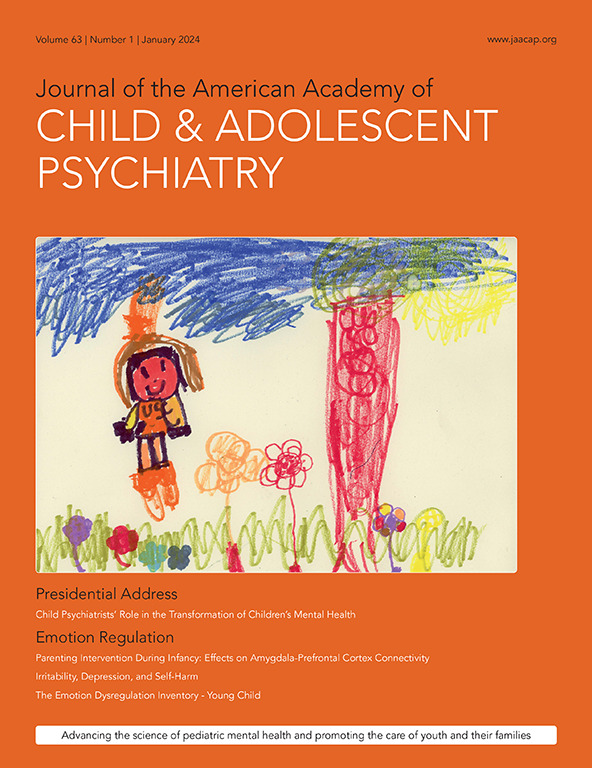Sexual Orientation Differences in Age of First Treatment for a Mental Health Diagnosis: A Population-Based Study of Childhood and Adolescence
IF 9.5
1区 医学
Q1 PEDIATRICS
Journal of the American Academy of Child and Adolescent Psychiatry
Pub Date : 2024-08-02
DOI:10.1016/j.jaac.2024.07.916
引用次数: 0
Abstract
Objective
The aim of the current study was to identify the age at which sexual orientation disparity in mental health diagnoses can be first identified, as well as gender and sexual identity subgroup differences in such treatment, in a population-based sample.
Method
Young people aged 16 to 25 (N = 10,406) participating in the probability-based Swedish National Public Health Survey in 2018 were included. This sample was linked to physician-assessed mental health care treatment history data starting when all participants were 8 years old using national health care registries.
Results
Participants reporting a sexual minority identity in adolescence and young adulthood were more than 3 times as likely to have been treated for an internalizing disorder diagnosis (eg, depression, anxiety) and more than twice as likely to have been treated for a neurodevelopmental disorder diagnosis during childhood than participants reporting a heterosexual identity. Sexual minority participants overall and women in particular were more likely to have been treated for an internalizing disorder diagnosis at an early age compared with heterosexual participants, with this disparity starting at age 13. The sexual orientation disparity in likelihood of treatment for a neurodevelopmental disorder diagnosis was particularly elevated among bisexual/pansexual women with this disparity starting in early/middle adolescence.
Conclusion
This population-based study linked to physician-assessed mental health diagnoses during childhood and adolescence identifies the age at which sexual orientation differences in treatment for common mental disorders emerge. The early emergence of this disparity suggests a potential benefit of interventions that facilitate social belonging for all youth.
Plain language summary
In this study, the authors explored the link between self-reported sexual orientation with physician-assessed mental health diagnoses and treatment history during childhood and adolescence. Using data from 10,406 participants in the Swedish National Public Health Survey, the authors found that those reporting a sexual minority identity in young adulthood were more than 3 times as likely to have been treated for depression and/or anxiety with this disparity starting at age 13. Sexual orientation disparity was particularly elevated among bi-/pansexual women, who have been previously treated for a neurodevelopmental disorder, with this disparity starting in early/mid adolescence. This study represents the first use of a population-based sample to identify the age at which sexual orientation differences in common mental disorders emerge. The early emergence of these disparities suggests a potential benefit of interventions that facilitate social belonging for all youth.
首次接受心理健康诊断治疗年龄的性取向差异:基于人口的儿童和青少年研究。
研究目的本研究的目的是在基于人口的样本中,确定首次发现精神健康诊断中性取向差异的年龄,以及此类治疗中的性别和性身份亚群差异:研究纳入了参加2018年基于概率的瑞典全国公共卫生调查的16至25岁的个人(n=10365)。该样本与医生评估的心理健康护理治疗史数据相关联,这些数据从样本中所有人8岁开始使用国家医疗保健登记册:与那些报告自己是异性恋者的人相比,在青春期和青年期报告自己是性少数群体的人接受内化障碍诊断(如抑郁、焦虑)治疗的可能性是后者的三倍多,在童年时期接受神经发育障碍诊断治疗的可能性是后者的两倍多。总体而言,与异性恋者相比,性少数群体,尤其是女性,更有可能在幼年时期就因内化障碍诊断而接受治疗,这种差异从 13 岁就开始了。双性恋/跨性别女性因神经发育障碍诊断而接受治疗的性取向差异尤其明显,这种差异从青春期早期/中期就开始了:这项首次基于人群的研究与医生评估的儿童和青少年时期心理健康诊断相关联,确定了常见精神障碍治疗中出现性取向差异的年龄。这种差异的早期出现表明,促进所有青少年社会归属感的干预措施具有潜在的益处。
本文章由计算机程序翻译,如有差异,请以英文原文为准。
求助全文
约1分钟内获得全文
求助全文
来源期刊
CiteScore
21.00
自引率
1.50%
发文量
1383
审稿时长
53 days
期刊介绍:
The Journal of the American Academy of Child & Adolescent Psychiatry (JAACAP) is dedicated to advancing the field of child and adolescent psychiatry through the publication of original research and papers of theoretical, scientific, and clinical significance. Our primary focus is on the mental health of children, adolescents, and families.
We welcome unpublished manuscripts that explore various perspectives, ranging from genetic, epidemiological, neurobiological, and psychopathological research, to cognitive, behavioral, psychodynamic, and other psychotherapeutic investigations. We also encourage submissions that delve into parent-child, interpersonal, and family research, as well as clinical and empirical studies conducted in inpatient, outpatient, consultation-liaison, and school-based settings.
In addition to publishing research, we aim to promote the well-being of children and families by featuring scholarly papers on topics such as health policy, legislation, advocacy, culture, society, and service provision in relation to mental health.
At JAACAP, we strive to foster collaboration and dialogue among researchers, clinicians, and policy-makers in order to enhance our understanding and approach to child and adolescent mental health.

 求助内容:
求助内容: 应助结果提醒方式:
应助结果提醒方式:


